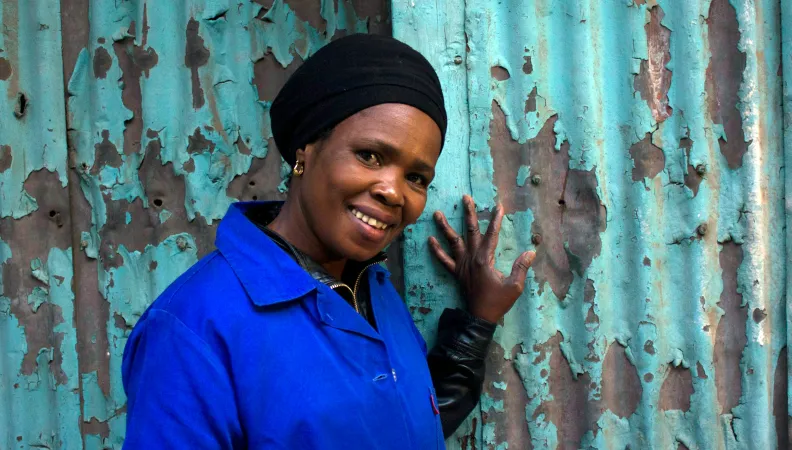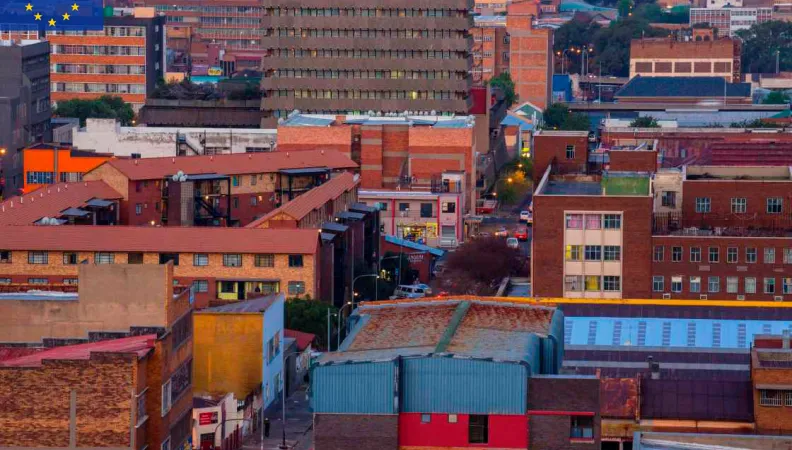Johannesburg, Afrique du Sud
Johannesburg
South Africa
 Extreme weather events resulting from the effects of climate change coupled with a global call for countries to reduce their greenhouse gas (GHG) emissions imply that the transition to a “green” economy is non-negotiable. The societal and policy discussions have moved on to trying to understand the transition possibilities and the economic and social implications of these in each country’s context. This research project will focus on the case of South Africa.
Extreme weather events resulting from the effects of climate change coupled with a global call for countries to reduce their greenhouse gas (GHG) emissions imply that the transition to a “green” economy is non-negotiable. The societal and policy discussions have moved on to trying to understand the transition possibilities and the economic and social implications of these in each country’s context. This research project will focus on the case of South Africa.
Context
South Africa is one of the largest GHG emitting countries due to its heavy reliance on coal for most of its energy needs. The South African government is cognisant of the fact that shifting away from carbon-intensive forms of technology to more sustainable ways of production means that some jobs will be destroyed, and new ones will be created. A concern therefore for policy makers is ensuring that the transition is just and that it will not exacerbate existing inequalities.
South Africa comes into this employment transition discussion facing a triple challenge: persistent high unemployment, inequality, and poverty. This situation has worsened since the 2007-2008 financial crisis and was further exacerbated by the recent COVID-19 pandemic. This complicates the discussion of an optimal social transition to a “green” economy.
This project is part of a wider research program on the just transition in South Africa, conducted with several South African research centres and in close collaboration with the South African authorities.
See also: Research on inequalities
Goal
The project will carry out a study of the South African labour market with the aim of identifying the proportion and distribution of workers engaged in “green” jobs and “brown” jobs – in other words, jobs that are ecologically sustainable and jobs that are not. It will also examine the possibilities of transitioning labour from brown jobs into low emitting sectors.
Method
We will measure green intensity as the share of total tasks in an occupation that are green. We will also identify the share of workers in green jobs using employment information from surveys such as the Quarterly Labour Force Surveys (QLFSs) and the Census. Using industry level information on pollution, we will go further to identify occupations more likely to be in highly polluting sectors than in any other sectors. This will be described as brown jobs. Next, we will utilise occupational tasks, skills, and knowledge information from the O*NET dataset to identify important skills for brown and green jobs. This will enable us to estimate the probability of transitioning workers to green jobs. Finally, to map the location of green jobs, we will use employment information from the Census, the Community Survey, and the Spatial Tax data.
Contact:
- Anda David, research officer, AFD
 Legal notice EU (project) Despite a democratic governance, well-established judicial, financial and human rights institutions and a positive policy framework, poverty and inequality are still largely cast along historical lines and in racial dimensions in contemporary South Africa. It remains highly unequal in its distribution of wealth, living standards, employment opportunities and household incomes. There is widespread discontent with the actual implementation of policy and the quality of delivered public services.
Legal notice EU (project) Despite a democratic governance, well-established judicial, financial and human rights institutions and a positive policy framework, poverty and inequality are still largely cast along historical lines and in racial dimensions in contemporary South Africa. It remains highly unequal in its distribution of wealth, living standards, employment opportunities and household incomes. There is widespread discontent with the actual implementation of policy and the quality of delivered public services.
Contexte
The inauguration of President Ramaphosa in February 2018 has offered the country an opportunity to put the South African project of Nelson Mandela back on track. But this will require confronting, head-on, the lack of progress towards a more balanced distribution of opportunities and incomes and the difficult political and economic questions that this raises. Will the benefits of political change be limited to a narrow elite or is more broad-based equitable development possible? What kinds of social, economic or institutional change might contribute to more rapid transformation of opportunities for the bottom half of the household income distribution? What kinds of constraints on power and privilege might contribute to fairer outcomes at the top tail of the distribution?
These difficult questions are of interest both in South Africa and internationally, and they are economic and institutional questions of considerable complexity. It is not just that a continued widening of inequality is unacceptable morally, it seems likely also that it threatens growth, social order and sustainability. Inequality reduction is under the spotlight in many countries and much work has been done internationally and in South Africa on understanding inequality.
This project is part of the first phase of the Research Facility on Inequalities, coordinated by AFD and funded by the European Commission's Directorate-General for International Partnerships over the 2017-2020 period. The first phase of the Facility has led to the conduct of 22 research projects and the publication of around 100 research papers and policy briefs.
Objectif
This project will draw on and consolidate this evidence-base and then fill some important, policy-relevant gaps that remain. By design, the research programme outlined below seeks to address distributional issues in both the bottom half and the top of the distribution. The work programme recognises from the outset that there are several dimensions of human development and wellbeing, and progress in some measures might be accompanied by deterioration in others. It recognises that economic growth does not necessarily lead to equitable outcomes – both poverty and inequality have self-reinforcing characteristics that are hard to counter.
The project will be undertaken in formal partnership with South Africa’s national statistical office, Statistics South Africa. Also, as important steps in the proposed research programme, a series of dialogues will be held between the researchers and key stakeholders, including representatives of government, business, organised labour and civil society – to seek advice, test ideas and contribute to consensus on possible policy reforms.
Méthode
The research project will be developed across three work streams:
- The implementation of the inequality diagnostic under the form of a report summarizing existing knowledge on South African inequality trends and policies. It will further add to this knowledge using available data, explore the implications of this new work and then take stock of data needs in order to make further progress in framing policies to overcome inequality.
- A paper on the role of earnings in the household inequality dynamics. It builds off preliminary evidence that a key aspect of the lack of support from the labour market into households is the volatility of employment and therefore earnings for the self-employed and other vulnerable workers.
- A paper on the interlinkages between population dynamics and spatial inequality. This paper is responsive to an often-expressed opinion from the policy community that migration is being driven by differences across provinces and regions in the quality of schooling, health, and other services.
Results
The diagnostic of inequality in South Africa, carried out by Statistics South Africa in partnership with the Southern Africa Labour and Development Research Unit (SALDRU), the African Centre of Excellence for Inequalities Research (ACEIR) in the EU-AFD Facility framework is available online: Inequality trends in South Africa: a multidimensional diagnosis of inequality.
This report was presented at a workshop involving all actors working to reduce inequality, held on 11 February 2020 in Philippi, Cape Town, on the occasion of the 30th anniversary of the release of Nelson Mandela. You will find here the synthesis of the workshop, including the presentations, discussions and debates held this day: Stakeholder engagement on inequality trends in South Africa.
Find the presentation of the research paper "Earnings Inequality over the Life-Course in South Africa" by Zocco Zizzamia (ACEIR, SALDRU-UCT, University of Oxford) during the second webinar of the Research Facility on Inequalities:
You may find the research papers here:
Contact:
- Anda David, Research Officer at AFD
 Legal notice EU (project) This study deals with the new forms of affordable housing and public housing in South African cities. The objective? To determine whether these projects help reduce economic inequalities and encourage social inclusion.
Legal notice EU (project) This study deals with the new forms of affordable housing and public housing in South African cities. The objective? To determine whether these projects help reduce economic inequalities and encourage social inclusion.
Context
Since the end of apartheid, the successive South African governments have put emphasis on a very proactive public-housing policy, notably by having built 2.7 million housing units for the disadvantaged classes. However, various sources estimate that another 2 million affordable housing units are still needed (which would concern 12 million people, or one-fourth of the population of South Africa). Furthermore, construction of the 2.7 million housing units has not eliminated slums, which continue to spread in the major South African cities. Finally, most of the public housing has been established in the outer peripheries of cities: this hinders access by the beneficiaries to the areas offering jobs and services and contributes to continued racial and social segregation.
The most recent trends have seen the private sector encouraged to participate in the construction or renovation of affordable housing.
This project is part of the first phase of the Research Facility on Inequalities, coordinated by AFD and funded by the European Commission's Directorate-General for International Partnerships over the 2017-2020 period. The first phase of the Facility has led to the conduct of 22 research projects and the publication of around 100 research papers and policy briefs.
Goal
The objective of this research project is to understand the impact of projects such as the “Integrated Housing Developments” or so-called “social” housing in the major South African cities (Johannesburg, Cape Town, and Durban). Other tools furthering social inclusion are also studied, such as the regulations and tax incentives that encourage production of affordable housing by the private sector, etc.
As part of this study, we cover both the question of reducing economic inequalities and the question of the scale at which inequalities should be examined: by neighborhood, by district, or citywide.
The study also defines the determinants and obstacles with regard to the production of public and affordable housing. These include the economic model, support from the public sector, private investment, regulatory framework, difficulties in implementation, and others.
Method
The research project makes a case study of several projects involving the production of subsidized housing in three major South African cities (Cape Town, Johannesburg, and Durban). Several socio-economic indicators are used to evaluate inequalities.Series of data on housing supply and demand have been gathered, from the 2000s to 2018. The study looks for the most disaggregated data possible, in order to identify tendencies within cities regarding segregation, inclusion, and exclusion.
The role of different sources of income is analyzed, in particular the incomes and expenditures related to housing, by cross-analyzing them with the Gini index on inequalities.
The study also has a qualitative component dealing with the forms of production and regulation of affordable housing in South Africa.
Results
You may find the research papers here:
- Social housing and upward mobility in South Africa
- The role of social housing in reducing inequality in South African cities
You may find the policy briefs here:
Contacts:
Irène Salenson, Research Officer, AFD
Ivan Turok, Executive Director in the Economic Performance and Development Unit of the Human Science Research Council
